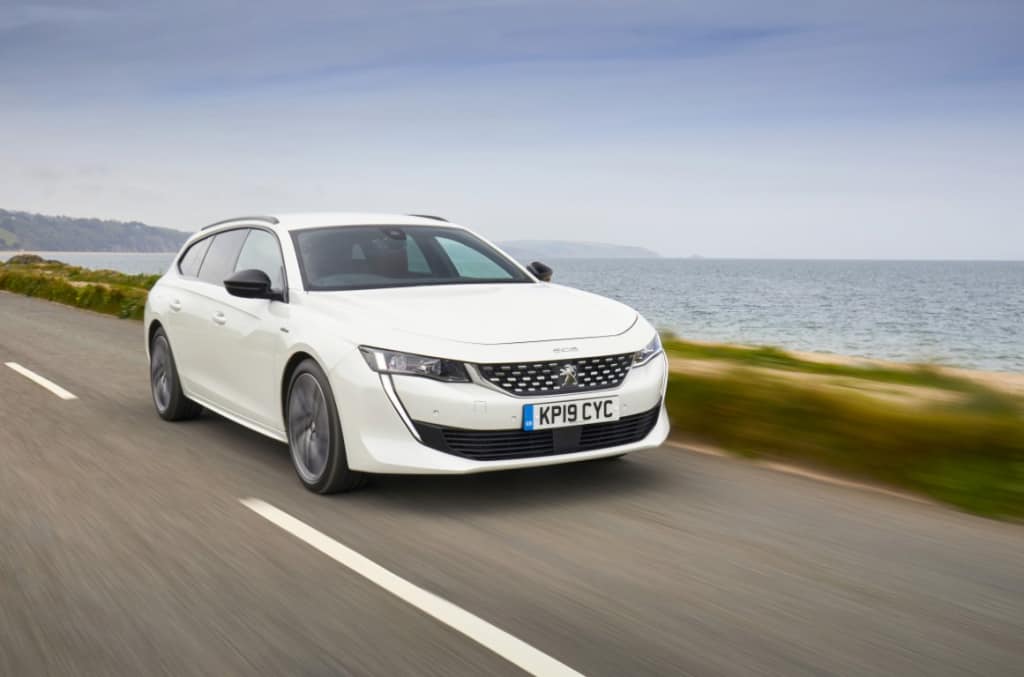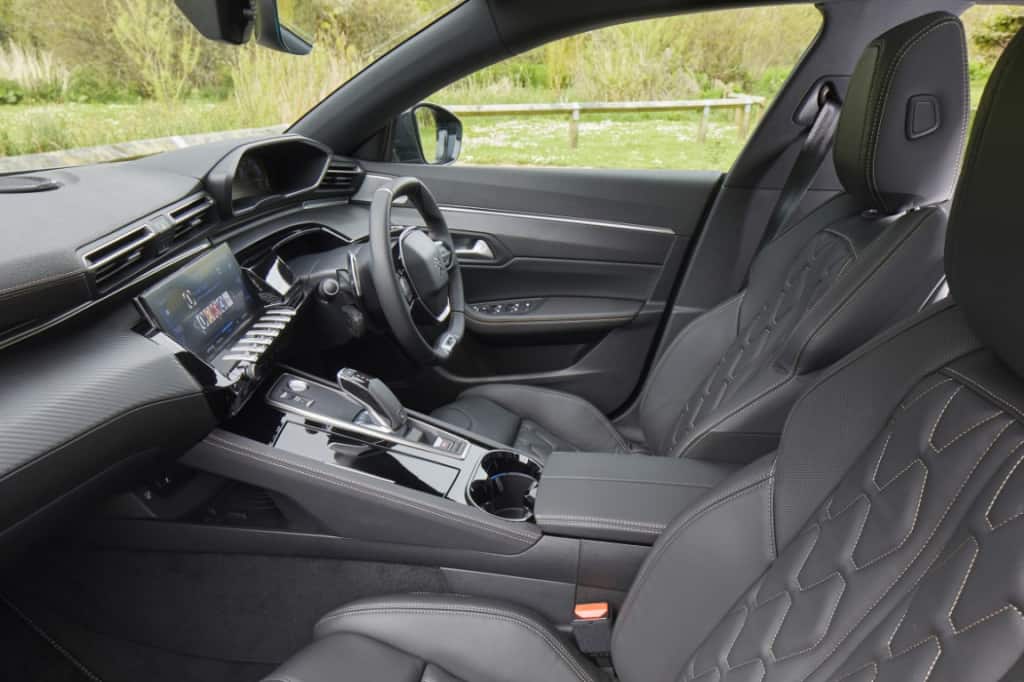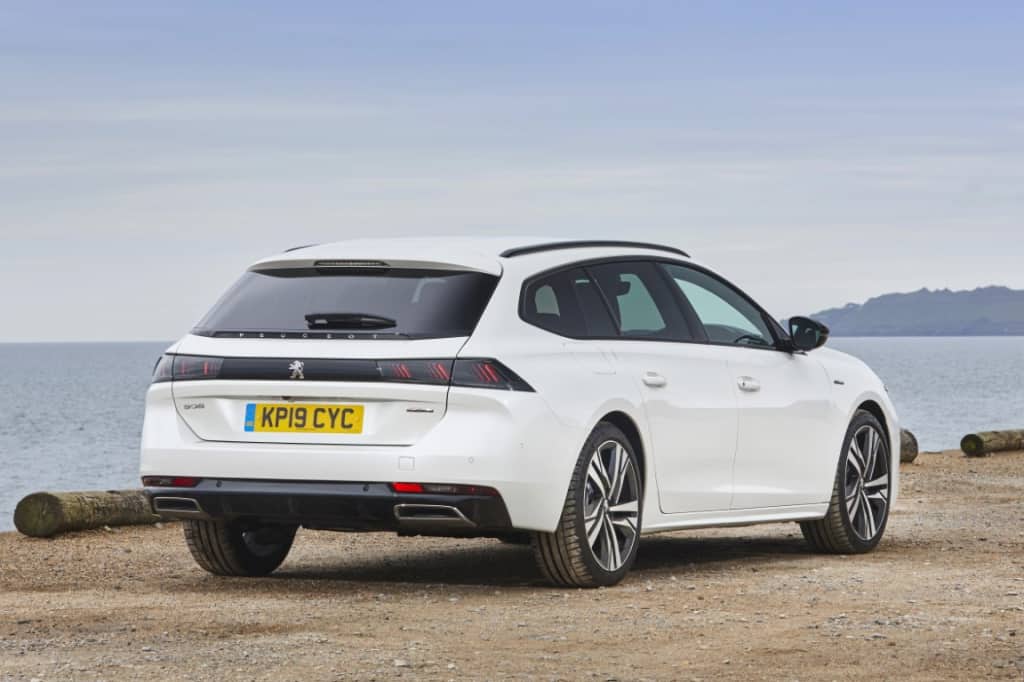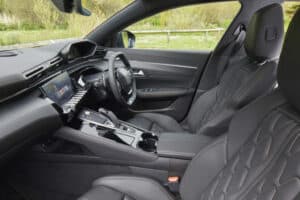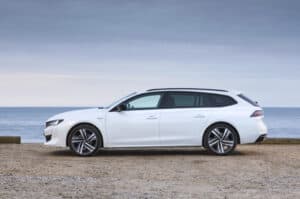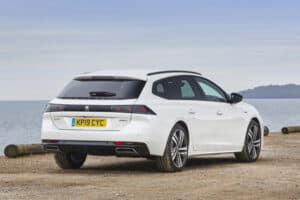Tell me more…
As expected, the SW swaps the saloon’s rakish roofline and hatchback tailgate for a more practical estate body, though unusually it retains frameless door glass, which gives a smart coupe-like look to the front doors when they’re open (they’re shared with the saloon), if a slightly odd appearance to the estate-specific rears.
There’s a choice of four-cylinder turbocharged petrol and diesel engines (including a plug-in hybrid), and five trim levels: Active, Allure, GT Line, GT and the First Edition, which is limited to 200 units in the UK.
Even the entry-level Allure gets dual-zone climate control, rear parking sensors, sat-nav with live traffic updates, voice recognition and Apple CarPlay/Android Auto/Mirror Link smartphone compatibility.
Our test car was fitted with the BlueHDi 160 engine and eight-speed auto gearbox – it’s the middle of three diesel choices, offering 161bhp and up to 51.1mpg. In GT Line trim, our test car also gets 18-inch alloys, gloss-black exterior trim and seats upholstered in Belomka ‘leather effect’ and Ornis cloth as standard.
What’s it like inside?
Just like the saloon, the interior has an elegant, sophisticated and almost avant garde feel that makes German rivals seem staid and predictable. The instrument panel has a wide, sleek appearance, and the high-quality feel of the satin-chrome shortcut keys and woven carbon-effect trim are complemented by the modern look of Peugeot’s configurable i-Cockpit digital instrument cluster and a 10-inch capacitive touchscreen. Our test car was upgraded with attractive Nappa leather upholstery, a pricey £1550 extra that added a far more luxurious touch. Mostly, though, you won’t need to splash too much extra, and perhaps the optional £400 electric tailgate is more essential.
The estate’s more upright roofline means it’s both easier to duck under the roof while climbing into the rear seats and there’s more headroom too, though the saloon is far from poor. Naturally there’s a much larger boot too, at 530 litres of space with the rear seats up. The rear seats have 60/40 split folding as standard, and fold flat to the floor to liberate a maximum 1780 litres of space. The saloon compares with 487 and 1537 litres.
How does the 508 SW drive?
It’s decent enough, but didn’t impress quite like the saloon we previously tested. Partly that’s because this is the mid-range diesel engine with 163bhp and the saloon we tried had the range-topping 177bhp version. But that’s not the full story, because there’s still adequate performance here for normal driving, and the turbodiesel is nicely isolated at a cruise. The bigger issue relates to the chassis, which has lost a good amount of the saloon’s suppleness, even when fitted with smaller 18-inch alloys compared with the 19s fitted to our saloon test car. It just never quite settles with the same long-legged feel, something that accounted for a big part of the saloon’s appeal.
In a nutshell
The SW estate version of the Peugeot 508 brings two key benefits over the saloon – most obviously a much larger, more practical loadbay. Less obviously, there’s easier access to the rear seats and more headroom because the roof line doesn’t drop down quite so dramatically.
Of those benefits, only the larger boot is likely to prove decisive in purchasing decisions, and we’d argue the saloon is superior in all other respects. Not only is more attractive, but it’s cheaper, more comfortable and better to drive too. If you can get by with its hatchback tailgate and already pretty large boot capacity, that’s the 508 you should buy. View ChooseMyCar’s full range of used Peugeot cars available on finance.
Similar car reviews
Also in the Peugeot 508 range is the Peugeot 508 GT, with its sleek fastback body, practical hatch and four trim levels it’s a great alternative option if you’re considering a Peugeot GT.
You cannot discount the Renault Megane R.S Trophy either, the feisty, sport version of the Megan, it’s a real bundle of energy.
A slight alternative to the Peugeot’s and Renaults, is the VW’s baby hatchback, the VW Polo. The latest model has sharp looks and a generous amount of space inside.
Sticking with estate cars, the Volvo V60 is spacious, has smart interiors and fantastic seats, as well as it’s city safety autonomous braking as standard, it’s a serious choice for any family car.
Finally, the humble Ford Focus has quietly and consistently been in the top 10 selling cars in the UK market, with its blend of practicality, versatility and slick gearboxes, it’s always been a popular choice with consumers.
Specs
| Price | £32,895 |
|---|---|
| Drivetrain | 1997cc 16v four-cylinder turbodiesel, eight-speed auto, front-wheel drive |
| Performance | 161bhp @ 3750rpm, 295lb ft @ 1750rpm |
| 0-62mph | 8.5sec |
| Top speed | 140mph |
| Efficiency | 42.2-51.1mpg, 122g/km CO2 |
| Weight | 1500kg |
| Length/width/height | 4778/1859/1420mm |





